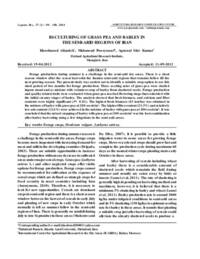BI-CULTURING OF GRASS PEA AND BARLEY IN THE SEMI-ARID REGIONS OF IRAN

Authors:
Forage production during summer is a challenge in the semi-arid dry areas. There is a short
season window after the cereal harvestin the Iranian semi-arid regions that remains fallow till the
next growing season. The present study was carried out to identify a suitable crop option to use this
short period of two months for forage production. Three seeding rates of grass pea were studied
inpure stand and as mixture with volunteer crop of barley from shattered seeds. Forage production
and quality related traits were evaluated when grass pea reached flowering stage that coincided with
the initial creamy stages of barley. The analysis showed that fresh biomass, and calcium and fiber
contents were highly significant (P< 0.01). The highest fresh biomass (43 ton/ha) was obtained in
the mixture of barley with grass pea at 200 seeds/m². The highest fiber content (23.5%) and relatively
low ash content (12.6%) were achieved in the mixture of barley with grass pea at 200 seeds/m². It was
concluded that the mixed cropping of barley with grass pea at 200 seeds/m² was the best combination
after barley harvesting using a few irrigations in the semi arid areas.
